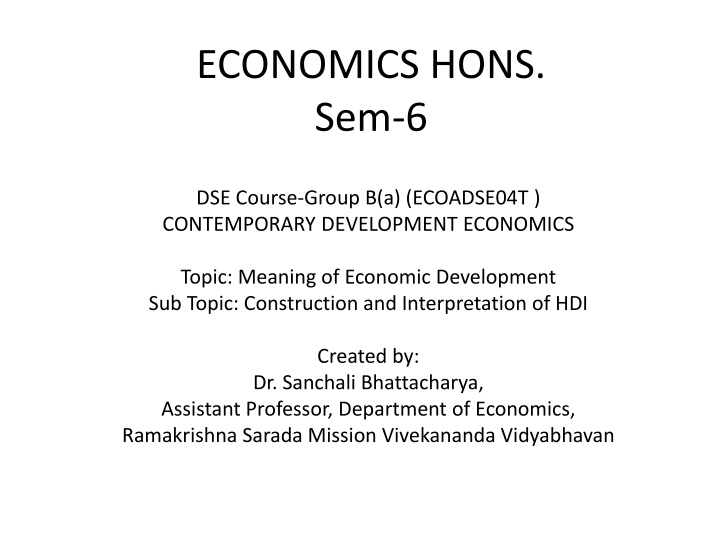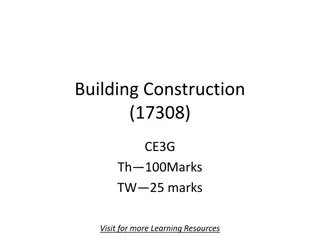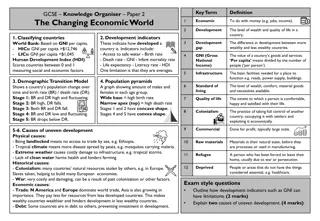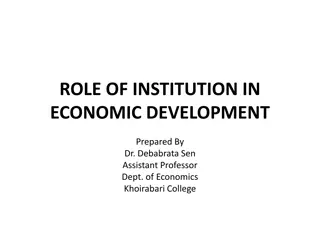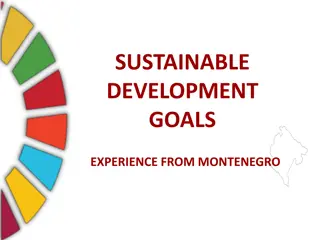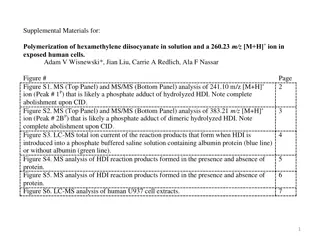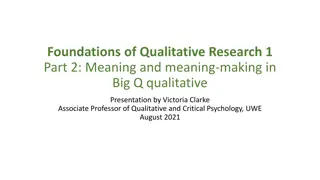Meaning of Economic Development: Construction and Interpretation of HDI
The Human Development Index (HDI) is a key measure of quality of life, assessing longevity, education, and standard of living. It comprises three dimension indices on health, knowledge, and income which are combined using the geometric mean. The process involves setting goalposts for minimum and maximum values, standardizing component indicators, and justifying certain thresholds based on historical evidence and global trends.
Download Presentation

Please find below an Image/Link to download the presentation.
The content on the website is provided AS IS for your information and personal use only. It may not be sold, licensed, or shared on other websites without obtaining consent from the author.If you encounter any issues during the download, it is possible that the publisher has removed the file from their server.
You are allowed to download the files provided on this website for personal or commercial use, subject to the condition that they are used lawfully. All files are the property of their respective owners.
The content on the website is provided AS IS for your information and personal use only. It may not be sold, licensed, or shared on other websites without obtaining consent from the author.
E N D
Presentation Transcript
ECONOMICS HONS. Sem-6 DSE Course-Group B(a) (ECOADSE04T ) CONTEMPORARY DEVELOPMENT ECONOMICS Topic: Meaning of Economic Development Sub Topic: Construction and Interpretation of HDI Created by: Dr. Sanchali Bhattacharya, Assistant Professor, Department of Economics, Ramakrishna Sarada Mission Vivekananda Vidyabhavan
Basic Concept of HDI (Human Development Index) The concept of different human development indicators are explained and suggested by the United Nations Development Program s(UNDP s) Human Development Reports (HDRs). Human Development Index (HDI) is the universally accepted measure of the quality of life published in UNDP annually. HDI is a composite index measuring average achievement in three basic dimensions of human development longevity, i.e., a long and healthy life which is measured by life expectancy at birth; knowledge which is measured by mean years of schooling and expected years of schooling and finally, decent standard of living which is captured by Gross National Income (GNI) per capita (PPP $). PPP, i.e., Purchasing power parity (PPP) measures how much a currency can buy in terms of an international benchmark (usually in dollars $), since the cost of goods and services differs between countries. So GNI per capita is measured in PPP $.
Three separate dimension indices on health, knowledge and income are constructed. Then geometric mean of three dimension indices of the three indicators gives the HDI. The Human Development Index (HDI) is a summary measure of achievements in three key dimensions of human development: a long and healthy life, access to knowledge and a decent standard of living. The HDI is the geometric mean of normalized indices for each of the three dimensions.
Steps to Calculate Human Development Index Values There are two steps to calculating HDI values. Step 1. Creating the dimension indices Minimum and maximum values (goalposts) are set in order to transform the indicators expressed in different units into indices between 0 and 1. Minimum goalpost is set as zero for Educational Indicators and very low values for others; Maximum goalpost is set at achievable target. Using these Maximum and Minimum values component indicators are standardized (see equation 1 below). They are set at the following values: Dimension Indicator Minimum Maximum Health Life (years) expectancy 20 85 Education Expected years of schooling (years) 0 18 Mean schooling (years) years of 0 15 Standard of living GNI per capita (2017 PPP$) 100 75,000
The justification for placing the natural zero for life expectancy at 20 years is based on historical evidence that no country in the 20th century had a life expectancy of less than 20 years. Maximum life expectancy is set at 85, a realistic aspirational target for many countries over the last 30 years. Due to constantly improving living conditions and medical advances, life expectancy has already come very close to 85 years in several economies: 84.9 years in Hong Kong, China (Special Administrative Region) and 84.6 years in Japan. Societies can subsist without formal education, justifying the education minimum of 0 years. The maximum for expected years of schooling, 18, is equivalent to achieving a master s degree in most countries. The maximum for mean years of schooling, 15, is the projected maximum of this indicator for 2025. The low minimum value for gross national income (GNI) per capita, $100, is justified by the considerable amount of unmeasured subsistence and nonmarket production in economies close to the minimum, which is not captured in the official data. The maximum is set at $75,000 per capita.
Having defined the minimum and maximum values, the dimension indices are calculated as: actual value minimum value maximum value minimum value (1) Dimension index = For the education dimension, equation 1 is first applied to each of the two indicators, and then the arithmetic mean of the two resulting indices is taken. Expected years of schooling and mean years of schooling are perfectly substitute, so arithmetic mean of the two education indices is used as average. Each additional dollar of income has a smaller effect on expanding capabilities. Thus for income the natural logarithm of the actual, minimum and maximum values is used.
Step 2. Aggregating the dimensional indices The HDI is the geometric mean of the three dimensional indices: HDI = (IHealth . IEducation . IIncome ) 1/3 Example: Sudan (from Technical Notes, HDR) Indicator Value Life expectancy at birth (years) 65.3 Expected years of schooling (years) 7.9 Mean years of schooling (years) 3.8 Gross national income per capita (2017 PPP $) 3,829 Note: Values are rounded. Health index =65.3 20 Expected years of schooling index =7.9 0 Mean years of schooling index =3.8 0 Education index =0.4380 + 0.2513 85 20 = 0.6971 18 0 = 0.4380 15 0 = 0.2513 = 0.3447 2 ln(3,829) ln(100) ln(75,000) ln(100) = 0.5506 Income index = Human Development Index = (0.6971 . 0.3447 . 0.5506)1/3 = 0.510
Human Development Categories The 2014 Human development Report introduced a system of fixed cutoff points for the four categories of human development achievements. The cutoff points (COP) are the HDI values calculated using the quartiles (q) from the distributions of the component indicators averaged over 2004 2013: COPq = HDI (LEq , EYSq , MYSq , GNIpcq), q = 1,2,3. For example, LE1, LE2 and LE3 denote three quartiles of the distribution of life expectancy across countries. This Report keeps the same cutoff points on the HDI for grouping countries that were introduced in the 2014 Report: Level of Development HDI Score Countries for Example (from HDR 2021-22) Switzerland, Norway, Iceland, Australia Very high human development 0.800 and above Maldives, Mexico, Tunisia, Colombia High human development 0.700 0.799 India, Bangladesh, Bhutan, Ghana Medium human development 0.550 0.699 Afghanistan, Mali, Niger, Guinea Low human development Below 0.550
Criticism of the Concept of HDI: HDI implicitly assumes trade-offs between its components. For example, the HDI measures health using life expectancy at birth and measures economic conditions using GDP per capita. So the same HDI score can be achieved with different combinations of the two. HDI does not take into account human rights and freedom as mostly important factor of the quality of life. Providing health attainments, educational attainments and improved GDP per capita are necessary to enjoy a decent standard of living for an individual and also the socio-political environment of the economy where these facilities are being provided is very much important in the question of quality of life of an economy. Another important drawback of HDI is that it does not consider sustainable development as the component of human development. The concept of sustainable development which can be defined as a concept of inter-temporal resource use based on the theory of inter-generational equity, i.e., future generations have enough resources so that they will be able to attain at least the same level of social well-beings as enjoyed by the present generation. As a measure of human development, HDI must be concerned with the fact that whether the developments sustain overtime or it is just the development for the time being.
References: Dasgupta, P. (1993). An Enquiry into Well-being and Destitution, Clarendon Press, Oxford. Planning Commission of India (2011). India Human Development Report, Government of India, Oxford University Press. Sen, A. (1981). Poverty and Famines: An Essay on Entitlement and Deprivation, Oxford University Press. (1984). Resources, Values and Development, Basil Blackwell Publisher Ltd. (1985). Commodities and Capabilities, North Holland Publisher. (1992). Inequality Re-examined, Harvard University Press. (1999). Development As Freedom, Oxford University Press. (2002). Rationality and Freedom, Belknap Press of Havard University Press. Sen, A. and Nussbaum, M.C. (Eds.). (1993). The Quality of Life, Oxford University Press. Sengupta, R. (2002). Human Well-Being and Sustainable Development, EPW, Oct. 19, 2002. UNDP (from 1990 to 2021-22 different year issues). Human Development Reports, Human Development Report Office of the UNDP.
